
The 365 GTC4 model was unveiled at the 1971 Geneva Show, and was effectively a replacement for two models in the range, the 365 GTC which had ceased production in 1970, and the 365 GT 2+2 that was dropped from production upon the announcement of the new model. It fulfilled the roll of the former admirably, by being a more conservatively and less aggressively styled coupe cousin to the 365 GTB4 berlinetta, but only partially succeeded in fulfilling the roll of the latter, as the rear seats of the 2+2 seating arrangement were marginal, for all but very small children.
They did however have the facility of folding backs, to provide a useful luggage platform. An unusual feature of the interior was that the seat centres and door trim were upholstered in a plaid cloth material, unique to this model, although the more normal full leather trim remained available upon request. From the outset both European and USA market versions were available, the latter being fitted with emission control equipment that sapped performance, and was recognisable by rectangular side marker lights on the front and rear wings.
This was the first new 12-cylinder Ferrari model announced after the Fiat takeover of road car production control in 1969, and for a completely new body style had a relatively short production run into the autumn of 1972, by which time 500 examples had been built. However, the mechanical layout was carried over into the succeeding 365 GT 2+2 model virtually unchanged, apart from a lengthened chassis.
The body style was very different from the models that it replaced, gone were the graceful rounded curves and the elliptical radiator grille, to be replaced by a much more angular wedge design, which was coming into vogue at the time. It had a very low nose featuring a full width black rubber front bumper that surrounded the shallow rectangular radiator grille, with rectangular driving lights and side/turn indicator light units housed in the extremities of the grille opening. Retractable twin headlight units were set in the flat upper nose panel between the bumper and leading edge of the full width bonnet, which had similar rectangular exhaust air outlets to those on the 365 GTB4 model. The front flowed with plain body sides into a five window cabin, in which the profile of the side glass could probably be best described as sharp teardrop shaped, which ran at a constant shallow angle through the boot lid into a neat Kamm tail. Triple lens rear light assemblies were mounted on either side of an inset tail panel, below which was a plain matt black bumper to balance the black rubber unit at the front of the car. The body was designed, constructed, and trimmed by Pininfarina, and then sent to Ferrari for the mechanical components to be fitted. It was constructed in steel with an aluminium bonnet and boot lid.
The bodies were mounted on a 2500mm wheelbase chassis, and this was the first Ferrari model to use a new factory reference number system prefixed with “F”, this was type reference F101 AC 100, and all were numbered in the odd chassis number road car sequence. The construction was along the same basic lines as the others of the period, with large section oval main tubes, cross bracing, and sub structures to support the body and ancillary equipment. The model was available in right-or left-hand drive form, with power-assisted steering as standard, as were electric windows and air conditioning. The standard road wheels were five spoke “star” pattern alloy, with a knock-off spinner on a Rudge hub, although the USA, and certain other market cars, had a large central chrome plated nut to meet the then current legislation, Borrani wire wheels were available as an option.
The engine was similarly structured to the 365 GTB4 unit, with twin overhead camshafts per bank in the V12 unit of 4390cc capacity, with a bore and stroke of 81mm x 71mm. Unlike that engine it did not feature dry sump lubrication, instead being fitted a standard wet sump system. The cylinder heads were also different, as the engine was fitted with side-draught rather than down-draught carburettors, to reduce the bonnet height. The new cylinder heads had the inlet ports between the camshafts, rather than on the inside of the vee on the 365 GTB4 unit, which allowed the oil filters and emission control equipment to sit in the vee.
As with the chassis, the engine was the first in a new numbering sequence, with factory type reference F 101 AC 000. It was fitted with twin banks of three twin-choke Weber 38DC0E59/60 carburettors, those of the USA market cars carrying the suffix “A”. A single coil and rear-of-engine mounted distributor ignition system was fitted on European market cars, with a twin distributor and electronic system fitted to USA market versions, to produce a claimed 320hp for both types. The USA market cars were also fitted with a number of devices to control exhaust gas emission, including a fast idle device, and an exhaust manifold air injection system. The engine drove through a flywheel-mounted clutch, via a coupled five-speed all-synchromesh gearbox, in the same manner and of virtually the same layout as the 365 GT 2+2 model, including the self-levelling rear suspension system.
Engine
- Type front, longitudinal 60° V12
- Bore/stroke 81 x 71 mm
- Unitary displacement 365.86 cc
- Total displacement 4390.35 cc
- Compression ratio 8.8 : 1
- Maximum power 250 kW (340 hp) at 6200 rpm
- Power per litre 77 hp/l
- Valve actuation twin overhead camshafts per bank, two valves per cylinder
- Fuel feed six Weber 38 DCOE 59/60 carburettors
- Ignition single spark plug per cylinder, two coils
- Lubrication wet sump
- Clutch single-plate
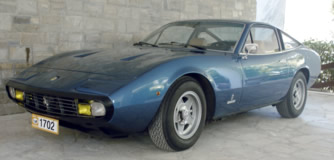 Chassis
Chassis
- Frame tubular steel
- Front suspension independent, unequal-length wishbones, coil springs over telescopic shock absorbers, anti-roll bar
- Rear suspension self-levelling, independent, unequal-length wishbones, coil springs over telescopic shock absorbers, anti-roll bar
- Brakes discs
- Transmission 5-speed + reverse
- Steering power-assisted recirculating-ball
- Fuel tank capacity 100 litres
- Front tyres 215/70 VR 15
- Rear tyres 215/70 VR 15
Bodywork
- Type two-seater coupé
- Length 4550 mm
- Width 1780 mm
- Height 1270 mm
- Wheelbase 2500 mm
- Front track 1470 mm
- Rear track 1470 mm
- Weight 1450 kg (dry)
Performance
- Top speed 260 km/h

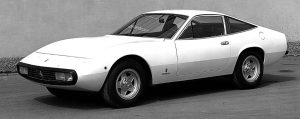

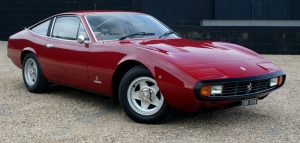

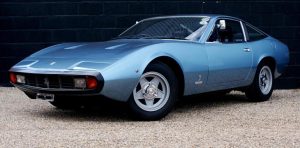
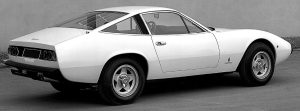
You must be logged in to post a comment.